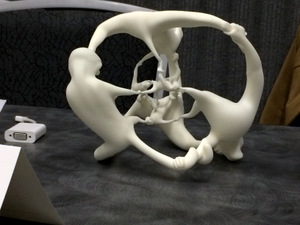
Mathematics Events at the 2015 AAAS Meeting
The 2015 annual meeting of the American Association for the Advancement of Science (AAAS) took place in San Jose, CA February 12-16. About 10,000 people attended the meeting, including many who attended Family Science Day on the weekend. Below are brief descriptions of some of the events as well as a slideshow of pictures from the meeting.
Symposium: From Art to Mathematics: A Visual Mode of Communication

Hypercube of monkeys, by Henry Segerman |
This symposium was organized by George W. Hart of Stony Brook University and was attended by many who enjoyed hearing about the connection between math and art. After Hart's introduction, Henry Segerman, Oklahoma State University, began the symposium with "How to Make Sculptures of Four-dimensional Objects," incorporating projections and polytopes into his talk. Andrea Hawksley of SAP Labs spoke about "Everyday Math Art." She had the audience make tetrahedra with rubber bands and act out a traveling wave that involved binary representation, and made Fibonacci lemonade. Hart finished the symposium with "Creating a Community with Geometric Constructions." He talked about the many group constructions he's led, which get people thinking about mathematical questions, saying, "The more math you know, the more power you have to create new and powerful things." |
Symposium: Bounded Gaps Between Prime Numbers: Individual Research Versus Crowd-Sourcing

Left to right: Carl Pomerance, Terence Tao--facing away--and Yitang Zhang, moments before the start of the symposium. |
It would be hard to beat the mathematical richness of this symposium, which was organized by Carl Pomerance, Dartmouth College, and Daniel A. Goldston, San Jose State University. Yitang Zhang, University of New Hampshire, talked about his work establishing that there is a bound on the distance between an infinite number of pairs of prime numbers. He did this work on his own. Terence Tao, UCLA, then talked about the online collaborative effort that lowered Zhang's bound from 70,000,000 to 246, in his talk "Polymath and the Primes." Paul Pollack, University of Georgia, finished with "Big Doings with Small Gaps," in which he reviewed many results about prime numbers. Attendees learned a lot in this symposium, which unfortunately took place on the last morning of the meeting. |
AMS Exhibit
 |
AMS Public Awareness Officer Annette Emerson and Assistant Director of the AMS Washington Office Anita Benjamin staffed the AMS exhibit, which featured the 2015 Calendar of Mathematical Imagery, Mathematical Moments--a series of over 100 posters that promote appreciation of the role mathematics plays in science, nature, technology and human culture--the 2015 Mathematics Awareness Month "Math Drives Careers" posters, and selected AMS books. Visitors to the exhibit included mathematicians, scientists from many disciplines, press, teachers, and Family Days participants. |
Here's a slideshow of photos of the symposia, the exhibits at Family Science Days, and San Jose.
Created with flickr slideshow.
The 2016 AAAS annual meeting will be in Washington, DC, February 11-15. The AAAS website has more information.
You can also read about mathematics at previous AAAS meetings: 2014, 2013, 2012, 2011, 2010, 2009, 2008, 2007, 2006, 2005, 2004, 2003, and 2002.
Text and photos by AMS Public Awareness Officers Mike Breen and Annette Emerson.

